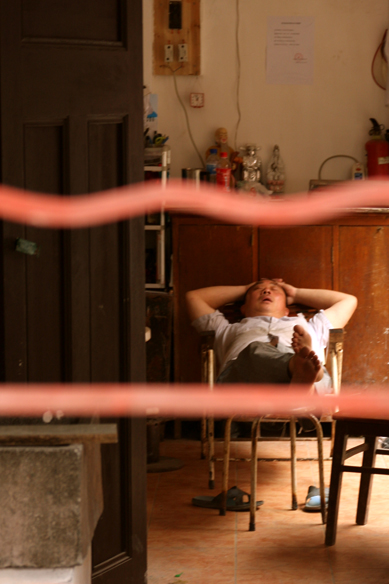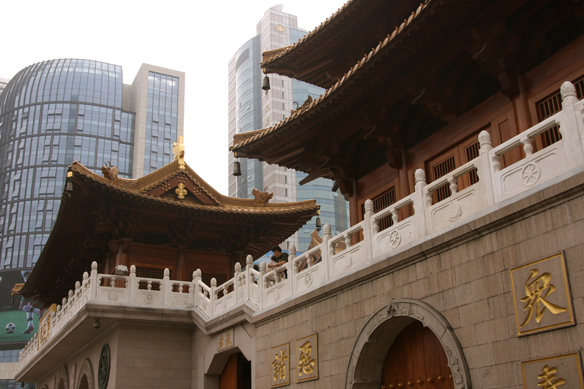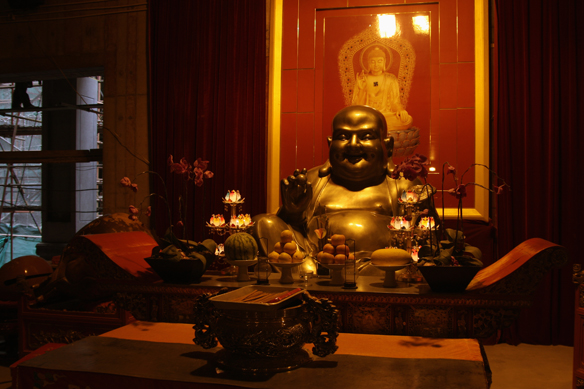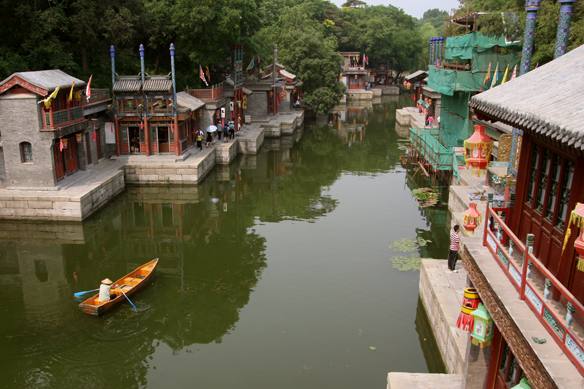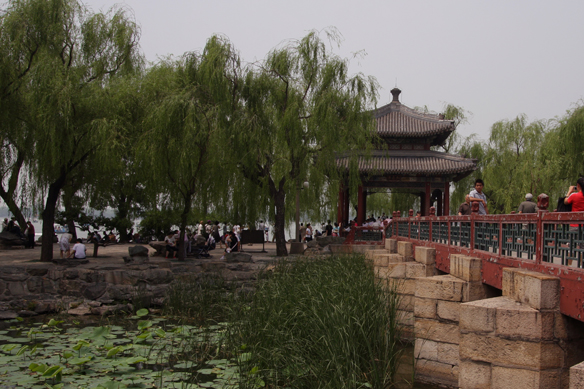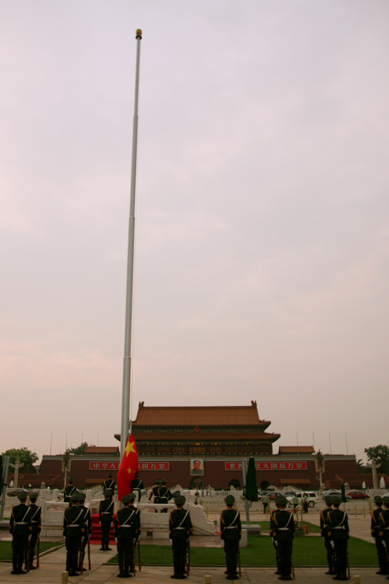June 29, 2010
Today is my last morning in Shanghai and, as I felt when I left Beijing, I’m also sad to leave Shanghai. It’s amazing how in such a short period of time you can grow to know people and enjoy their company so much. I think that’s one of the main reasons people decide to go backpacking. In the real world, we usually interact with each other in the context of our mundane everyday tasks. Here, however, you tend to only see a small slice of someone’s personality – the portion that’s not obscured by the inconveniences of day-to-day life. Clearly, this makes for a very spotty image of the “real world,” but it’s exciting nonetheless and I hope I’ll have many more of these experiences throughout my life. Moving forward, I’ll be making my way to Kuala Lumpur for several days before I end my trip in Singapore. In the meantime, enjoy what few photos I’ve been lucky enough to take in what has turned out to be a terribly muggy and rain-filled week in Shanghai!
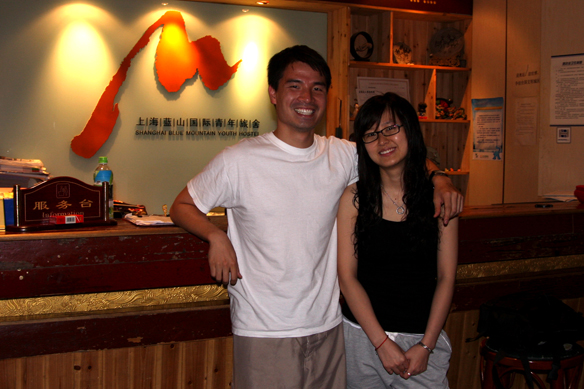
Welcome to the Blue Mountain Youth Hostel! This is where I spent countless hours updating my webpage, meeting new people, and immersing myself in the excitement of soccer, especially during the World Cup! Also, this is JJ, a hostel host. She helped me with my stay and suggested some nice sightseeing venues.
These two were a hilarious together! To the left is Cindy and to the right is Amirah. Amirah is a college student in Pennsylvania and has been learning Chinese since junior high and Cindy is a recent college graduate who works at Blue Mountain. One evening, Amirah and I went shopping at Yu Gardens, and since her Chinese is better than mine, I had her translate and negotiate on my behalf. It was great to see the confused look on all of the vendors’ faces. In fact, one vendor kept expecting me to talk and refused to speak to Amirah. Now
that was a hilarious shopping experience. As for Cindy, she’s been working at Blue Mountain for the past two months and is a good friend of Amirah’s. Cindy prides herself on being a traditional Chinese girl and is adamant on finding a traditional guy (Chinese or not) and we’ve had plenty of fun conversations on this topic! When they are out together, these two have such great chemistry that I love being in their company.
Finally, here is a picture of me and Amy. Amy was one of the first people I met at Blue Mountain and she’s been living there for the brief duration of her most recent job. Now, she’s spending some time relaxing before she jumps back into the job search. One fun quirk about Amy is that she’s really into Japanese anime, and on more than one occasion, I’ve seen her watch over 40 episodes in just one day. As you can see, Amy doesn't joke around when it comes to anime!
June 26, 2010
As promised, here are the pictures I took at the World Expo! This was actually my second visit; the first time I came, it was raining and I thought it was best not to bring my camera, for fear it would get wet. Ironically, this time, it was raining even more! But my time in Shanghai is quickly coming to a close and since the weather wasn’t going to clear up any time soon, this was probably one of the few opportunities I would have to photograph the Expo. And although it was a challenge to get these shots, I'm pretty happy with the result! But without further ado, I present my World Expo pictures!

This is the central exhibition hall for the China Pavilion, known as the "Crown of The East". According to the Expo website, the distinctive roof is "made of traditional dougong or brackets, which date back more than 2,000 years." I didn't have time to explore the exhibit, but from what I've heard and from what I've read, the pavilion focuses on the recent rural to urban migration and China's continued effort to manage its carbon footprint. The building was fairly expansive and arguably one of the largest, if not the largest, of all the pavilions.
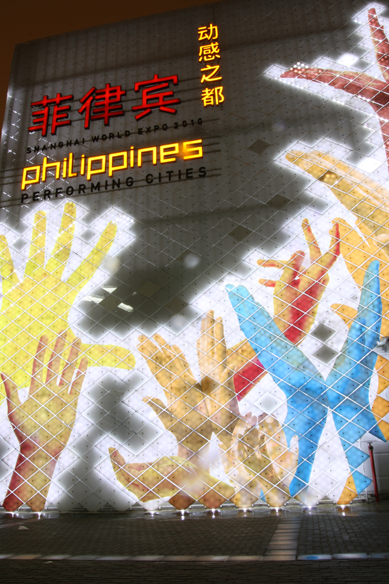
Ah, the motherland! As much as I love the Philippines and the memories I have of growing up in Quezon City, the Philippines pavilion was a huge disappointment. There wasn’t much more than a couple of guitars and a few traditional costumes on display. I was really hoping the sponsors would take this opportunity to highlight the country's recent industrial developments and some of its rich and vibrant history. However, since they didn't do so, I've decided to spend a moment to do it for them. One of the lesser known facts about the Philippines is that following World War II, they had the second largest economy in Asia, second only to Japan. In fact, economists at that time expected the Philippines to overtake Japan to become the largest economy in the region. This was mostly due to the strong growth in its economy at the time, but it was also due in part to its close relationship with the US. The Philippines was annexed from the Spanish by the Americans in 1898 and became a US Comonwealth territory in 1935 before gaining independence in 1946. Unfortunately, since then, the country has been plagued with corruption and government mismanagement. To this day, I sometimes wonder how things would be different if the Philippines had remained a US Commonwealth territory.
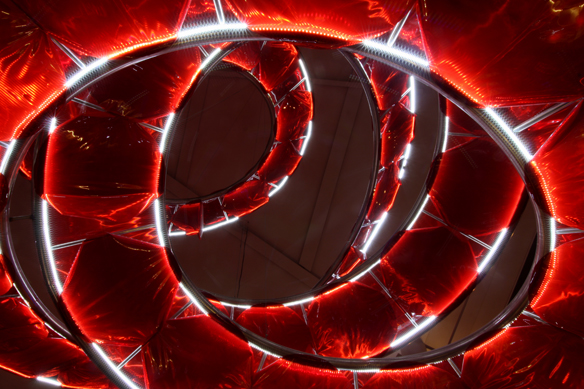
Venezuela’s pavilion wasn’t particularly memorable, but what did leave an impression on me was the open air courtyard with hammocks and small theater areas. Not far from that courtyard was this large glass sculpture hanging from the ceiling. As you can see from the photograph above, it’s a bit mesmerizing and forms a natural frame for the picture.
España! This was a really popular pavilion and, regardless of the time, there was always a line. You could also see from the design that the Spanish put a great deal of care into creating their pavilion. The shell of the Spanish pavilion makes ingenious use of wicker panels (a material of wood straws woven together) to create this wall with an almost-fluid appearance. Also, because it's flammable, there were signs everywhere asking people not to smoke!
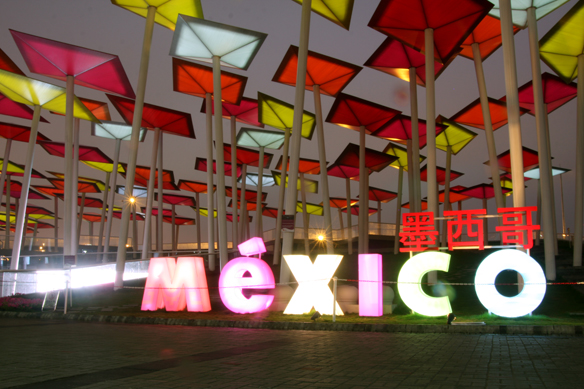
Mexico's pavilion was pretty fun! It was actually mainly underground and this was the above-ground portion of the exhibit. I think this quote from the Expo website says it best: "The Mexico Pavilion features a Kite Forest combining colorful kites and green grass, representing the ideas of future urban life as advocated by Mexico. The site will mostly be an open area with an exterior grass slope that creates a large green public space, which embodies ecology, environment protection and peace." I wasn’t especially drawn to the underground exhibit, but I really enjoyed the surface display of the pavilion. It was a refreshing sight among the towering pavilions nearby.

Bienvenidos a Chile! This was, by far, my favorite pavilion. The design team for the pavilion did a great job weaving together Chilean culture with Chile's goals of building greener cities and improving the country's standard of living. For example, this is a picture of a typical Chilean home that someone attached upside down to the ceiling of a room in the exhibit. I thought it was a wonderfully creative way to introduce a slice of daily life to the exhibit. There were a lot of interesting details including a TV playing Chilean TV shows, books, magazines and other daily items on "display" throughout the home.

This photograph was taken at the Thailand Pavilion. The Thais really went out of their way to develop a guided "tour" which was a much different approach from the other pavilions I saw. For instance, instead of just walking into the pavilion, you were led through three separate video showings. This picture was taken at the first showing where they showed videos of modern Thailand. After watching this video, we were led to a second showing where a robot narrated another video about Thai history. Finally, we were led to a room showing a 3D video, similar to something you would find at Disneyland. It was a fun pavilion and I appreciated the variation in their approach. Yet, at the same time, I would have liked to explore the pavilion at my own pace. Overall though, the videos were great and definitely worth watching!
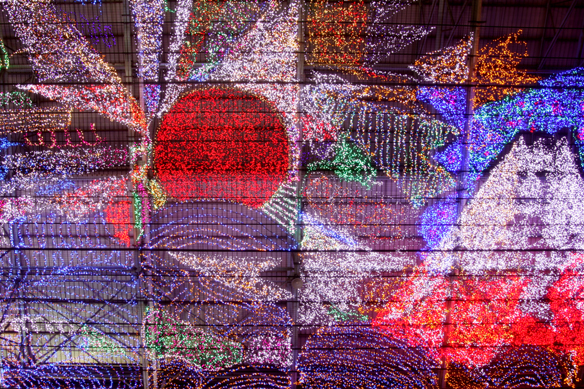
Finally, the photograph above was taken at the entrance/exit at Gate 1. The surface of the roof you see in this photograph was actually a dynamic display. Periodically, different portions of the image embedded into the roof would light up. After I spent some time watching it, I decided it would be cool to set up a long exposure shot to capture what the full image would look like if all the different portions lit up at once. And as a result, we see the black swirls on the purple-colored roofing.
June 24, 2010
I visited the World Expo a few days after I arrived in Shanghai, but since the exhibition is so massive, I have only seen a small segment of the overall event. I've been meaning to make my way back to see more of it, but the weather has been muggy with scattered showers and I'm just not interested in holding my flimsy umbrella over my camera setup as I get soaked by rain. At the same time, it's come to my attention that it'll be raining for the next few days and I'm beginning run out of other things to do. I may just pull the trigger on this project tonight and bite the bullet. If it's going to rain for the rest of the time I'm here, I may as well get this over with now. In the meantime, I wanted to share with you the pictures I've taken since I last posted.
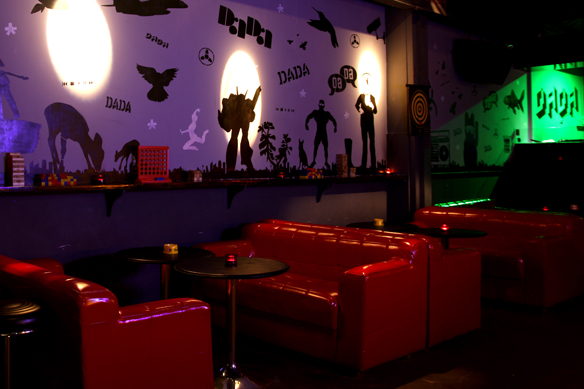
I went bar hopping with a friend the other night and we ended the evening at a dive bar called Dada. Surprisingly, there was no one there when we arrived and instead of taking off, I thought it would be fun to grab a drink and take a few pictures. I mean, how often do you find an empty bar where they'll let you take pictures?! As you can see, this place had a retro-diner/punk rock theme and just beyond this frame was a projector showing the World Cup. It looked like it could be a really happening place on the weekends, but I guess Tuesday nights just aren't their nights.
I snapped this photo on a small street just off West Nanjing Road. I almost couldn't blame this guy; it was 1 o'clock in the afternoon and the humidity practically sucks the energy out of you. Personally, I've found myself crawling back to the hostel around this time to take my daily siesta.
Not far from the location of the previous photo, I came across this old-timer taking down his laundry after a day of line drying. I couldn't help but laugh when I saw him with his high-water pants and snug waistband. Looking at this, it's clear where my father gets his sense of style.
This is the exterior wall of the Jing'an Temple, built in the 13th century during what is known as the Three Kingdoms Period. I imagine it belongs to a rare group of historical landmarks that are integrated into modern cities. It's rather astonishing to consider that this is an 800 year old establishment nestled in a busy city center and surrounded by skyscrapers, roads and modern infrastructure. Places like these are what make Shanghai unique, if not charming, in its own post-modern way.
Typical of the differences between guidelines in Beijing and Shanghai, I was allowed to take pictures
inside the temple! Like with the Lama Temple in Beijing, this temple was so peaceful, I felt as though I could crawl into a corner and fall asleep here for days.

Meet Jeff, a tea shop owner who invited us into his shop for a tea-tasting. He had an amazing grasp of English and when I found out he had come from a rural mountainous region of China and had only graduated from high school, I was even more impressed by his understanding of English. To give you some perspective, his spoken English was far better than most people from Hong Kong, and students in Hong Kong are taught in English beginning in primary school and through college. After spending an hour with him, it became clear he had a natural knack with languages. For instance, in addition to English and Chinese, he had also learned Korean, Spanish and Japanese. The whole time, I couldn't help but wonder what he could have done had he been given the opportunity to attend college to develop this amazing talent of his. At the end, we walked out with a ton of stuff, including a lucky pig I bought for myself. Seeing how things seem to be going well enough for him, maybe that luck will rub off on me?

Finally, I ended the day with a hot-pot meal with Steve, his girlfriend, Cathy, and Steve's older brother, Jeff (not pictured). Steve and I go back nearly 7 years ago when I met him at UCLA orientation. I believe he was the 2nd person I met at orientation, and although we haven't had much time to catch up since college, it was great to see him again and hang out with him in Shanghai. He's been living in China for the past 3 years and is now fluent in Chinese! Beginning in August though, he will be back in America studying for his MA in International Studies.
June 22, 2010
I arrived in Shanghai a few days ago and something about this city has really resonated with me. There always seems to be something to do and see here. I can see why this city seems to have such broad appeal. If I were to compare it to other US cities, Shanghai is to Beijing as New York City is to Washington, D.C. In just three days, I've had a chance to explore the World Expo, walk through the French Concession and take pictures by The Bund. It's been a pretty exciting week, but before I dive into my new pictures of Shanghai, I wanted to clean house with some photos of Beijing I forgot to post.

This is a picture of the lawn in front of Tienanmen Gate. What I liked most about this photo was that it encompassed on one end, the gardener working on the shrubs, and at the other end, the iconic portrait of Chairman Mao wearing his Mao suit. Before the Mao suit was called as such, it was originally the Chinese equivalent to the Western business suit, but after Mao took power in 1949, he tried to get everyone to wear these suits so that no one would be seen as better off than the next person. It was part of his vision to bring a sense of equality to the working class. It's hard to measure, even now, the progress Mao contributed to that vision. But, these days, the population is absolutely stratified by income and wealth. And this photo really captures a bit of that irony; Mao had always championed for the laborers and this photo illustrates almost a reversal of the status of the working class in modern Chinese society, even under the eternal gaze of the Chairman himself.

This is a photo of the Forbidden City in Beijing. The Forbidden City was the imperial palace for generations of the Chinese royal family and was built sometime in the 15th century. For the most part, it's comprised of a number of residences where the emperors' concubines and first wives would live. It also includes several large courts where official business would be held. It wasn't until 1912 that Pu Yi, the last Emperor of China, was ousted from power and the area was no longer the political center of China.

This is the Younghe Temple, also known as the Lama Temple, in Beijing. It is one of the largest Tibetan Buddhist temples in the world and is also where many monks come to study. I was hoping to get much better pictures here, but following the trend I've seen at other temples, they don't allow pictures inside, so I had to settle for this photo taken from outside. There were a lot of people burning incense and the place was really peaceful, so peaceful that I even decided to take a nap on one of the park benches. :)
Another photo of Lama Temple. I was really struck by the vibrant use of color here - even the hue of the pillars was a really deep brick red.
This was the train I rode from Beijing to Shanghai and it took me on what must be the worst trip I have ever taken in my life. I got stuck with what they call a "hard seat" (which is the 2nd to lowest of 5 levels of seating they have) and had to endure a grueling 13 hour train ride in one of these cabins. To give you a sense of how bad this was, imagine stripping away all the cushions from an economy class seat on an airplane. Then, after everyone is seated, add 100 people into the aisles (these people had what they called "standing tickets," which was the lowest of the 5 levels). The place was so crowded that I found people sleeping
underneath the seats and two kids sleeping
in the sink (sinks were located just outside of the toilets). In fact, the "toilets" were just squatters with a hole leading to the train tracks. This was definitely the worst riding experience I've ever had and for anyone looking to save a buck on travel in China, my advice is to pony up. This was only 13 hours and I've heard of people riding this hard seat (and in some cases, standing) for up to 24 hours. Needless to say, I was excited/relieved/overjoyed to finally get into Shanghai by the 13th hour.

This is a photo was taken in a shop at Tian Zi Fang, a district known for its artsy establishments. It was recommended to me by one of the hostel workers here at Blue Mountain. Tian Zi Fang maintains the architectural style of what a lot of people might call "Old Shanghai". The exterior of the buildings follow a lot of the structure of the Shikumen, a residential style from the 1860's. In that sense, it's very similar to the hutong's in Beijing. The one difference is that the interiors of the buildings here have been completely gutted and renovated and where there were once homes, there are now restaurants, shops and homes to many artists.
These are pictures I took by the Bund, opposite the river, in what is known as Puxi. Two of the most well known buildings in this photograph are the HSBC Bank and the Custom's House located near the middle of the photo. They both stand as a testament to Shanghai's Pearl of the Orient reputation in the 1920's.
This is the iconic Shanghai skyline we are all so familiar with. This is on the other side of the Huangpu River in Pudong. Some of the more famous buildings include the Oriental Pearl Tower (far left), the Shanghai World Financial Center (near the far right) and the Jin Mao Tower (in the mix). The Shanghai World Financial Center is the 2nd largest building in the world and I hope to make my way to the viewing area on the 100th floor before I leave.
June 18, 2010
Today is my last day in Beijing and I wanted to make one last post before I take the train down to Shanghai. As promised, below are pictures of Leo Hostel as well as pictures from the Summer Palace and the flag lowering ceremony at Tiananmen Square. Before leaving today, I plan to see the Lama Temple and have one last meal with David and Martin. I've had a really great time here in Beijing and I'm glad this was the first city I ever backpacked to. It definitely makes me very excited about future trips, especially the next leg of my trip to Shanghai.
These next three pictures are from the Summer Palace, a vast garden originally built 800 years ago. This park is centered around Kunming Lake and Longevity Hill. The photo above was taken near the north entrance and it shows one of many of man-made streams that run throughout the area.
This is the shore of Kunming Lake. I actually came to the Summer Palace for the Dragon Boat Festival but unfortunately, we arrived too late and missed it. Still, it was a nice to see the garden and spend time with the other backpackers.
This is the Tower of Buddhist Incense at the top of Longevity Hill, the highest point at the Summer Palace. This building was destroyed during the 1860 when Anglo-French Allies invaded China and set fire to this building. Since then, the building has seen 3 wars, been rebuilt, demolished, ransacked, renovated and restored.
This is the beginning of the flag lowering ceremony at Tiananmen Square. There are two flag ceremonies held each day, one in the morning for the flag raising ceremony and another late in the evening for the flag lowering ceremony. In both instances, they block off Chang-An Jie (Chang-An Road) to allow troops to converge onto Tiananmen Square to perform their procession. Looking back, I should have made it to the morning session. I have heard that it's quite inspiring to stand there, bleary-eyed watching the flag rise over the thin crest of sunrise. But for those of us who can't wake up at 4:45 AM, these evening ceremonies certainly capture the ethos of that event.
These are the members of the guard that are responsible for performing the flag lowering ceremony.
This is the tail end of the ceremony where they begin to unhinge the flag from the pole. These members of the guard eventually march back to the Forbidden City where they put away the flag until the next morning.
This is a view of the Leo Hostel from the street. The great thing about this location is that the street immediately in front of Leo is mostly closed off to traffic. I say mostly because there are still a lot of motorbikes and an occasional loading van that drive through. Nevertheless, it's mainly a pedestrian street with easy access to restaurants and shops in either direction.

This is the lounge area of the Leo. They probably had the best setup in regards to communal areas of the three hostels I visited in Beijing. For instance, this movie room was right next to the bar area which also served as the walk way between the main living area and the front entrance. The fluidity of the design really allowed people to convene together. It essentially provided people a reason to stop by after a long day of sightseeing to just hang out and watch a movie (or in this case, the World Cup) or share drinks. It made me think about the utilization of common spaces and what a difference a well-planned design makes. Of course, my next stop will be Shanghai, which has served as an international model of sorts for an entirely different model of space utilization, one based on the creation of an uber-modern metropolis. It will be interesting to compare that with the deeply historical influences in Beijing.
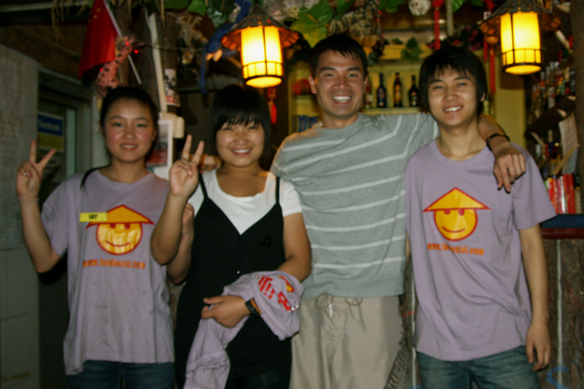
Finally, the last photo I took with the hostel workers here. From left to right: Sky, Jenny, me and Martin. Each one of these guys have been terribly nice to me throughout my stay in Beijing and I can definitely say that I'll miss them when I leave. Thanks all!!














